|
|
 |
|
Calanoida ( Order ) |
|
|
|
Diaptomoidea ( Superfamily ) |
|
|
|
Pontellidae ( Family ) |
|
|
|
Labidocera ( Genus ) |
|
|
| |
Labidocera madurae A. Scott, 1909 (F,M) | |
| | | | | | | Syn.: | ? Labidocera nerii : Cleve, 1901 (p.7);
Labidocera hawaiiensis : Peterson, 1975 (p.27, Rem., abundance); | | | | Ref.: | | | A. Scott, 1909 (p.169, figs.F,M); Sewell, 1932 (p.363, figs.F,M); 1948 (p.324); Nyan Taw, 1974 (p.270, Rem.); Silas & Pillai, 1973 (1976) (p.806, figs.F,M, Rem.); Marques, 1976 (p.996); Greenwood & Othman, 1979 (p.237); Goswami & Goswami, 1979 a (p.259, figs. caryotypes); Lakkis, 1984 (p.293, figs.F,M, Rem.); Yen & al., 1992 (p.495, figs., tab.1, Rem.: mechanoreception); Conway & al., 2003 (p.131, figs.F,M, Rem.).; Vives & Shmeleva, 2007 (p.506, figs.F,M, Rem.); Mercier & al., 2013 (p.760, neural ultrastructure); Sanu & al., 2016 (p.95, figs. F, M, Table 1, 2, 3, molecular identification) ; Abo-Taleb, 2019 (p.367, 369: Key F, M, Rem., abundance, Table 2, figs.F, M). | 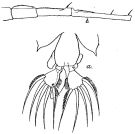 Issued from : R.B.S. Sewell in Mem. Indian Mus., 1932, X (continued). [p.364, Fig.120]. Female (from Nicobar Is.): a, urosome (dorsal). Male: b, A1 (knee-joint of the grasping).
|
 issued from : A. Scott in Siboga-Expedition, 1909, XIX a. [Plate L, Figs.9-16]. Female (from Madura Strait): 9, habitus (dorsal); 10, rostrum; 11, A1; 12, basipodite and endopodite of P1; 13, P5. Male: 14, urosome (dorsal); 15, right A1; 16, P5.
|
 issued from : E.G. Silas & P.P. Pillai in J. mar. biol. Ass. India, 1973 (1976), 15 (2). [p.806, Fig.15]. Female (from Andaman Islands): a, urosome (dorsal); b, rostrum (anterior view); c, P5. Nota: Lateral cephalic hooks wanting. Dorsal eye lenses feeble, small and placed apart. A1 23-segmented. Urosome 2-segmented; genital segment asymmetrical, considerably inflated at right mid-lateral margin; anal segment very small. Caudal rami symmetrical. Male: d, urosome (dorsal); e, right A1 (geniculate part); f, P5.
Scale as in Calanopia minor.
|
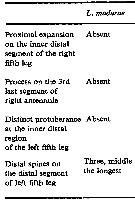 issued from : Nyan Taw in Austr. J. mar. Freshwat. Res., 1974, 25. [p.270, Table 1]. Male: Characteristics.
|
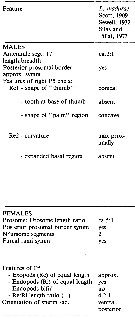 issued from : J.G. Greenwood & B.H.R. Othman in J. Plankton Res., 1979, 1 (1). [p.237] Characters in L. madurae compared with other species within the super-species detruncata (see L. cervi, L. farrani, L. caudata, L. detruncata, L. pavo, L. bataviae and L. sinolobata, with reference sources).
|
 issued from : J. Yen, P.H. Lenz, D.V. Gassie & D.K. Hartline in J. Plankton Res., 1992, 14 (4). [p.500, Fig. 2, A]. First antenna of L. madurae (from Kaneohe, Oahu, Hawaii). Camera lucida drawing showing 23 antennal segments ranging in length from 0.030 mm (segment 4) to 0.200 mm (segment 18) and in diameter from 0.020 mm (segment 21) to 0.150 mm (segment 1). Long setae occurred on segments 3, 6, 13, 22 and 23 (the latter two pointing posteriorly) and at least two long featherd setae were observed on the last distal segment.
|
 issued from : J. Yen, P.H. Lenz, D.V. Gassie & D.K. Hartline in J. Plankton Res., 1992, 14 (4). [p.500, Fig. 2, B-C]. First antenna of L. madurae. Scanning electron micrographs of the fathered and smooth setae and palps near the base of A1 (B) and a distal segment bearing two setae and one blunt palp (C). Scale bars: 0.040 mm.
|
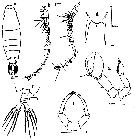 Issued from : V.F. Sanu, S. Bijoy Nandan, J. Deepak & M. Harikrishnan in Mar. Biodiv., 2016, 46 (1). [p.98, Fig. 2]. Female (from Kavaratti and Minicoy Islands): a, habitus (dorsal xiew); b, A1; d, rostrum; f, P5. Male (from same localities): c, geniculate right A1; d, rostrum); e, urosome (dorsal view); g, P5 (arrow indicates thumb-like process on the exopodite) Female: - One pair of circular dorsal eye lenses that are feeble, small and placed apart. - Rostrum deeply bifurcated symmetrically ptoduced posteriorly into pointed processes. - A1 23-segmented, extend to the end of the urosome. - Genital segment moderately large and symmetrical, with the middle of the right side considerably inflated. - Anal segment very short. - Caudal rami symmetrical, longer than broad. Endopodites P1 to P4 are 2-segmented, in contrast to 3-segmented exopodites. - P5 nearly symmetrical; exopodites furnished with 2 outer marginal spines; the apex terminates in 3 subequal spines, the apex of the endopodite is not bifurcated. Male: - Urosome 5-segmented; 4th and 5th urosomal segments much shorter than the others. - Right A1 geniculate, segments 18 and 19-21 with dorsal denticulated plates. - Short, curved thumb-like process on the proximal outer margin of the 1st segment of the right exopodite of P5; inner margin of hand with a small median spine; palm simple; the claw-like segment long and narrow; apical segment of the left exopodite elongate and ovate, twice as long as broad; outer margin furnished with 1 spine, and the apex bears 3 spines; inner margin with a pad of fine hairs
|
 Issued from : H.A. Abo-Taleb in Egyptian J. Aqua. Res., 2019, 45. [p.369]. Key to species of Labidocera in the Red Sea. Female: 1 - Anterior end of cephalosome rounded without median crest. 2 - Lateral hooks absent. 3 - Urosome 2-segmented. 4 - Caudal rami symmetrical. 5 - P5 exopod tip is 3 unequal terminal spines. 6 - P5 endopods symmetrical, conical shape with tapered end. Male: 1 - Anterior end of cephalosome rounded without a median crest. 2 - Last posterolateral end of metasome almost symmetrical. 3 - Right P5 chela with exopod 1 has long and stout thumb, small seta on the inner margin between thumb and claw.
| | | | | Compl. Ref.: | | | Sherman, 1963 (p.220: fig.9); Lakkis, 1976 (p.83: Rem.); Kovalev & Shmeleva, 1982 (p.85); Moraitou-Apostolopoulou, 1985 (p.303, occurrence/abundance in E Mediterranean Sea, Rem.: p.313); Madhupratap & Haridas, 1986 (p.105, tab.1); Lakkis, 1990 (p.63); Madhupratap & al., 1991 (p.947, Rem.: p.951); Lenz & al., 1996 (p.1, behaviour); Mauchline, 1998 (tab. 8, 78); Hassett & Boehlert, 1999 (p.571); Lenz & al., 2000 (p.337); Lakkis & al., 2005 (p.152); Kovalev, 2006 (p.67: Lessepsian migration); Waggett & Buskey, 2008 (p.111,Table 1); Zenetos & al., 2010 (p.397); Jagadeesan & al., 2013 (p.27, Table 3, seasonal distribution) | | | | NZ: | 5 | | |
|
Distribution map of Labidocera madurae by geographical zones
|
| | | | | | | | |  issued from : J. Yen, P.H. Lenz, D.V. Gassie & D.K. Hartline in J. Plankton Res., 1992, 14 (4). [p.502, Fig. 4]. issued from : J. Yen, P.H. Lenz, D.V. Gassie & D.K. Hartline in J. Plankton Res., 1992, 14 (4). [p.502, Fig. 4].
Neural activity from the A1 of Labidocera madurae from Kaneohe Bay, Hawaii.
Left side: spontaneous background activity. Right side: responses to a variety of mechanical stimuli (tap). All recordings are 40 ms long
Compare with Labidocera madurae, Euchirella curticauda, Undinula vulgaris, Pleuromamma xiphias. |
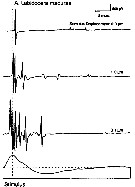 issued from : J. Yen, P.H. Lenz, D.V. Gassie & D.K. Hartline in J. Plankton Res., 1992, 14 (4). [p.504, Fig. 5A]. issued from : J. Yen, P.H. Lenz, D.V. Gassie & D.K. Hartline in J. Plankton Res., 1992, 14 (4). [p.504, Fig. 5A].
Threshold sensitivities of the first antenna of L. madurae (from Kaneohe, Hawaii) showing the displacement required at each time to peak displacement to elicit a response 50% of the time.
Responses curves of 3 individuals (open circle, square, triangle). |
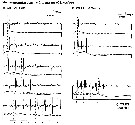 issued from : J. Yen, P.H. Lenz, D.V. Gassie & D.K. Hartline in J. Plankton Res., 1992, 14 (4). [p.507, Fig. 9]. issued from : J. Yen, P.H. Lenz, D.V. Gassie & D.K. Hartline in J. Plankton Res., 1992, 14 (4). [p.507, Fig. 9].
Neural activity recorded from the A1 of L. madurae (from Kaneohe Bay, Hawaii) in a phase-locked response to 1.0 µm oscillatory movements of the distal seta (A) and the whole A1 (B).
Note that the downward movement of the displacement trace corresponds to a distal bend of setae in (A) and a proximal one in (B). |
 Issued from : H.A. Abo-Taleb in Egyptian J. Aquat. Res., 2019, 45. [p.371, Table 2]. Issued from : H.A. Abo-Taleb in Egyptian J. Aquat. Res., 2019, 45. [p.371, Table 2].
Average values with standard deviation and ranges (individuals/m3) in the different studied habitats (SG: seagrass, CR: coral reef, SSL: sheltered lagoon, and OW: open sea.
See Labidocera euchaeta fig.1: sampling sites and Table 1: measured physical environmental parameters in the northern Red Sea. |
| | | | Loc: | | | E Medit. (Lebanon, Turkey: Iskenderoun Bay), Red Sea, Indian (Madagascar, Seychelles, Laccadive Is., Lakshadweep Archipelago, Gulf of Mannar, Palk Bay, Andaman Is.), Indonesia-Malaysia, Hawaii, Kaneohe Bay | | | | N: | 22 | | | | Lg.: | | | (5) F: 2,5; M: 1,9; (256) F: 2,8-2,11; M: 1,96-1,62; (333) F: 2,45; (1219) F: 2,11-2,80; M: 1,62-1,96; {F: 2,11-2,80; M: 1,62-1,96} | | | | Rem.: | Neritic.
This species would be of lesseptian origin in the Mediterranean Sea.
This species belongs to the L. detruncatagroup (Fleminger, 1967).
First record in the Red Sea by Abo-Taleb (2019, p.367, 372).
See in DVP Conway & al., 2003 (version 1) | | | Last update : 07/06/2021 | |
|
|
 Any use of this site for a publication will be mentioned with the following reference : Any use of this site for a publication will be mentioned with the following reference :
Razouls C., Desreumaux N., Kouwenberg J. and de Bovée F., 2005-2025. - Biodiversity of Marine Planktonic Copepods (morphology, geographical distribution and biological data). Sorbonne University, CNRS. Available at http://copepodes.obs-banyuls.fr/en [Accessed December 26, 2025] © copyright 2005-2025 Sorbonne University, CNRS
|
|
 |
 |











